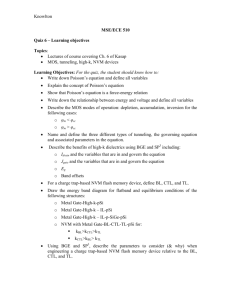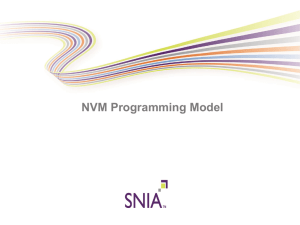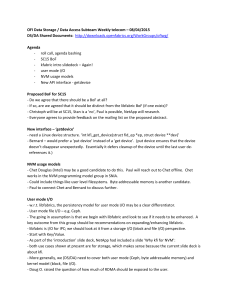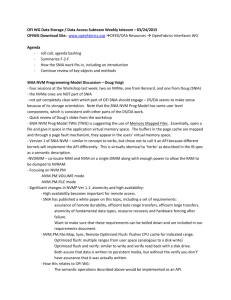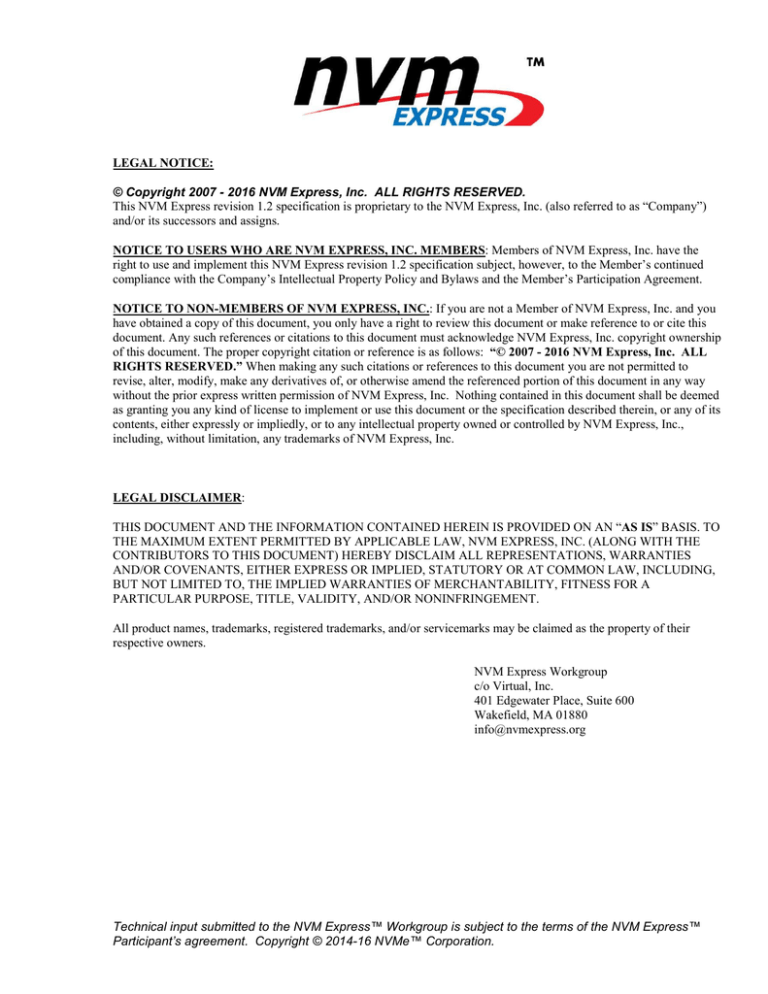
LEGAL NOTICE:
© Copyright 2007 - 2016 NVM Express, Inc. ALL RIGHTS RESERVED.
This NVM Express revision 1.2 specification is proprietary to the NVM Express, Inc. (also referred to as “Company”)
and/or its successors and assigns.
NOTICE TO USERS WHO ARE NVM EXPRESS, INC. MEMBERS: Members of NVM Express, Inc. have the
right to use and implement this NVM Express revision 1.2 specification subject, however, to the Member’s continued
compliance with the Company’s Intellectual Property Policy and Bylaws and the Member’s Participation Agreement.
NOTICE TO NON-MEMBERS OF NVM EXPRESS, INC.: If you are not a Member of NVM Express, Inc. and you
have obtained a copy of this document, you only have a right to review this document or make reference to or cite this
document. Any such references or citations to this document must acknowledge NVM Express, Inc. copyright ownership
of this document. The proper copyright citation or reference is as follows: “© 2007 - 2016 NVM Express, Inc. ALL
RIGHTS RESERVED.” When making any such citations or references to this document you are not permitted to
revise, alter, modify, make any derivatives of, or otherwise amend the referenced portion of this document in any way
without the prior express written permission of NVM Express, Inc. Nothing contained in this document shall be deemed
as granting you any kind of license to implement or use this document or the specification described therein, or any of its
contents, either expressly or impliedly, or to any intellectual property owned or controlled by NVM Express, Inc.,
including, without limitation, any trademarks of NVM Express, Inc.
LEGAL DISCLAIMER:
THIS DOCUMENT AND THE INFORMATION CONTAINED HEREIN IS PROVIDED ON AN “AS IS” BASIS. TO
THE MAXIMUM EXTENT PERMITTED BY APPLICABLE LAW, NVM EXPRESS, INC. (ALONG WITH THE
CONTRIBUTORS TO THIS DOCUMENT) HEREBY DISCLAIM ALL REPRESENTATIONS, WARRANTIES
AND/OR COVENANTS, EITHER EXPRESS OR IMPLIED, STATUTORY OR AT COMMON LAW, INCLUDING,
BUT NOT LIMITED TO, THE IMPLIED WARRANTIES OF MERCHANTABILITY, FITNESS FOR A
PARTICULAR PURPOSE, TITLE, VALIDITY, AND/OR NONINFRINGEMENT.
All product names, trademarks, registered trademarks, and/or servicemarks may be claimed as the property of their
respective owners.
NVM Express Workgroup
c/o Virtual, Inc.
401 Edgewater Place, Suite 600
Wakefield, MA 01880
info@nvmexpress.org
Technical input submitted to the NVM Express™ Workgroup is subject to the terms of the NVM Express™
Participant’s agreement. Copyright © 2014-16 NVMe™ Corporation.
NVM Express™ Technical Errata
Errata ID
001
Revision Date
1/25/2016
Affected Spec Ver.
NVM Express™ MI 1.0
Corrected Spec Ver.
Errata Author(s)
Name
Company
Austin Bolen
Dell
Peter Onufryk
PMC
John Carroll
Intel
Jason Gao
HGST
Myron Loewen
Intel
Judy Brock
Samsung
Chris Sneed
HGST
Errata Overview
This ECN addresses typos and requests for clarifications received during the 45-day NVMe-MI 1.0
member review period. Please refer to revision history for a detailed list of changes.
Revision History
Revision Date
Change Description
10/01/2015
Initial Errata
10/08/2015
Clarified section 1.4
10/22/2015
Clarified Invalid opcode
10/29/2015
11/5/2015
11/12/2015
Fixed Invalid Parameter typo. Added clarifications for SMBus addresses and
commands to a non-idle command slot.
Changed Command Processing language based on feedback from the
workgroup. Edited Figure 30 to add Command Slot specific column
Clarified Command Slot specific in Figure 30. Propagated reserved to
Figure 75 and 76. Clarified Invalid Opcode edit
11/17/2015
Further edits to section 4.3
12/10/2015
Fixed figure 75 (removing SQE DW8)
1/13/2016
Added errata overview description
Technical input submitted to the NVM Express™ Workgroup is subject to the terms of the NVM Express™
Participant’s agreement. Copyright © 2014-16 NVMe™ Corporation.
Description of Specification Changes
Modify a portion of Figure 91 (PCIe I/O Write) as shown below:
Bit
31:19
18:16
15:00
Description
Reserved
Base Address Register (BAR): This field specifies the PCI Base Address Register (BAR) of the I/O
space to be written. BARs are located beginning at 10h in PCI Configuraiton space and the value of
this field specifies the starting offset of the associated BAR. For a 64-bit BAR, this field should
correspond to the lower 32-bits of the BAR.
Value
0h
1h
2h
3h
4h
5h
6h-7h
BAR Offset
10h
14h
18h
1Ch
20h
24h
Reserved
Length (LENGTH): This field specifies the number of bytes to be read written.
Modify a portion of Figure 96 (PCIe Memory Write) as shown below:
Bit
31:19
18:16
15:00
Description
Reserved
Base Address Register (BAR): This field specifies the PCI Base Address Register (BAR)
of the memory space to be written. BARs are located beginning at 10h in PCI Configuraiton
space and the value of this field specifies the starting offset of the associated BAR. For a
64-bit BAR, this field should correspond to the lower 32-bits of the BAR.
Value
BAR Offset
0h
10h
1h
14h
2h
18h
3h
1Ch
4h
20h
5h
24h
6h-7h
Reserved
Length (LENGTH): This field specifies the number of bytes to be read written.
Modify a portion of section 6.1 (NVMe Admin Command Request and Response Data) as shown
below:
NVMe Admin Commands may contain data as part of the Command Message. This data is passed in the
NVMe Data field instead of using PRP Lists or SGL segments. The PRP Entry 2 (PRP2) and Metadata Pointer
(MPTR) fields within the NVMe Admin Commands are reserved.
Replace Figure 75 (NVMe Admin Command Request Format) as shown below:
Technical input submitted to the NVM Express™ Workgroup is subject to the terms of the NVM Express™
Participant’s agreement. Copyright © 2014-16 NVMe™ Corporation.
+3
+2
7 6 5 4 3 2 1 0
7 6 5 4 3 2 1 0
Byte 0
>
Reserved
Byte 4
>
Controller ID
Byte 8
>
+1
+0
7 6 5 4 3 2 1 0 7 6 5 4 3 2 1 0
R
O
R
NVMe-MI
Msg Type
R
Command Flags
CSI CI
Message Type
Opcode
Submission Queue Entry Dword 1
...
Byte 24
>
Submission Queue Entry Dword 5
Byte 28
>
Data Offset
Byte 32
>
Data Length
Byte 36
>
Reserved
Byte 40
>
Reserved
Byte 44
>
Submission Queue Entry Dword 10
...
Byte 64
>
Submission Queue Entry Dword 15
Bytes
68 to N
>
NVMe Request Data (optional)
Byte M
>
Message Integrity Check
Modify a portion of Figure 76 (NVMe Admin Command Request Description) as shown below:
Byte
39:36
43:40
36
47:44
Description
Submission Queue Entry Dword 8 (SQEDW8): Submission Queue Entry Dword 8 as
defined in the NVMe specification
Submission Queue Entry Dword 9 (SQEDW9): Submission Queue Entry Dword 9 as
defined in the NVMe specification Reserved
Submission Queue Entry Dword 10 (SQEDW10): Submission Queue Entry Dword 10
as defined in the NVMe specification
Modify a portion of section 1.4 (Architectural Model) as shown below:
Technical input submitted to the NVM Express™ Workgroup is subject to the terms of the NVM Express™
Participant’s agreement. Copyright © 2014-16 NVMe™ Corporation.
An NVMe storage device, such as a PCIe SSD, that implements this specification, consists of an NVMe NVM
Subsystem with one or more PCIe Management Endpoints ports. There may be up to one Management
Endpoint per PCIe port and and an optional SMBus/I2C port. Each Management Endpoint port has a Port
Identifier that is less than or equal to the Number of Ports (NUMP) field value in the NVM Subsystem Information
Data Structure. The pPort iIdentifier for a PCIe port is the same as the Port Number field in the PCIe Link
Capabilities Register.
Modify a portion of Figure 17 (Response Message Status Values) as shown below:
Value
03h
Description
Invalid Command Opcode: Invalid command opcode field
value. The associated command opcode field is not valid.
Invalid opcodes include reserved and optional opcodes that
are not implemented.
Error Reponse Format
Refer to Error!
Reference source not
found.
Modify a portion of section 4.2.2 (Invalid Parameter Error Response) as shown below:
An invalid parameter error response is generated for error responses where the Status field is set to 03h (i.e.,
Invalid Parameter).
Modify a portion of section 1.5 (Conventions) as shown below:
Some fields or registers are 0’s based values. In a 0’s based value, the value of 0h corresponds to 1; other
values similarly correspond to the value+1.
SMBus/I2C addresses are written as 8-bit hex values where bits 7:1 contain the 7-bit SMBus/I2C address and
bit 0 is cleared to 0b.
Modify a portion of section 2.2 (SMBus/I2C) as shown below:
The SMBus/I2C Management Endpoint shall be accessible at a power-up SMBus/I2C address of 0x3Ah and
should be SMBus ARP-capable (as defined in the SMBus 3.0 specification). If the NVM Subsystem is
“Discoverable” (as defined in the SMBus 3.0 specification), the device shall issue a “Notify ARP Master”
command when the NVM Subsystem is ready to communicate.
If the NVM Subsystem implements an SMBus/I2C interface, then VPD information shall be accessible from the
Management Endpoint using Sequential Read and Random Read operations as defined by the IPMI Platform
Management FRU Information Storage Definition specification.
The VPD shall be accessible using I2C read operations from a FRU Information Device at a power-up
SMBus/I2C address of 0xA6h and should be SMBus ARP-capable (as defined in the SMBus 3.0 specification).
If the FRU Information Device is “Discoverable” (as defined in the SMBus 3.0 specification), it shall issue a
“Notify ARP Master” command when the FRU Information Device is ready to communicate.
Modify a portion of section 4.3 (Command Processing Model) as shown below:
NVMe-MI utilizes Command Slots for command servicing processing. Command Slots are logically used for
MCTP NVMe-MI Request Message and Response Message assembly. Together with the request/response
processing model, Command Slots provide a mechanism for message flow control. A Management Controller
should not send a new Command Message to a Command Slot until the Response Message for the previously
issued command to that Command Slot has been received. Associated with each Each Management Endpoint
are contains 2 Command Slots. Each Command Slot that each includes a state information and a Pause flag
(refer to 4.4.4).
A Management Controller sends a Request Command Message to a Management Endpoint and that targets a
specific Command Slot in the Management Endpoint. The Management Endpoint assembles MCTP packets
into Command Messages targeting a Command Slot. When a Management Endpoint receives MCTP packets
for a Command Message that target a Command Slot, the packets are kept in a buffer associated with that
Command Slot to be assembled. The Command Slot remains allocated to the Command Message until
Technical input submitted to the NVM Express™ Workgroup is subject to the terms of the NVM Express™
Participant’s agreement. Copyright © 2014-16 NVMe™ Corporation.
processing servicing of the command Command Message has completed, the associated Response Message
has been transmitted, and the Command Slot command servicing transitions back to the Idle state.
A Command Message is the only type of multi-packet MCTP NVMe-MI message that may be received by a
Management Endpoint. The maximum number of Command Messages in flight to a Management Endpoint is
equal to the number of Command Slots. The operation of each Command Slot is independent, allowing a
Management Controller to have 2 independent streams of Command Messages to a Management Endpoint.
The Command Message associated with each Command Slot are processed in parallel. If the NVM Subsystem
implements multiple Management Endpoints, then command processing servicing of each Management
Endpoints occurs in parallel. A NVM Subsystem that implements N Management Endpoints may have up to 2N
commands executing Command Messages serviced in parallel.
The Command Servicing State Diagram in Figure 21 is used to describe functional requirements and does not
mandate an implementation. A Command Slot may be in 1 of 4 possible states. These states as well as valid
state transitions are shown in Figure 1.
Figure 1: Command Servicing Slot State Diagram
Response Message
Transmitted
or
Abort
Start of
Command Message
Idle
Abort or
Error
Transmit
Receive
More
Processing
Required sent
Response
Required
or
Resume
Abort
Process
Complete
Command Message
Received
1. Idle: The state when there is no Command Message associated with the Command Slot. This is the
default state of the command servicing state machine a Command Slot (e.g., following a reset). A
Command servicing Slot transitions from Idle to the Receive state when the first MCTP packet of a
MCTP NVMe-MI command message is received (i.e., an MCTP packet with the SOM bit in the MCTP
packet header set to ‘1’, and the Message Type set to 4h, and the CSI field set to the corresponding
Command Slot Identifier).
2. Receive: The state when the first packet of a Command Message has been received and the message
is being assembled and/or validated. A Command servicing Slot transitions from Receive to the Idle
state when an Abort Control Primitive is received, an error is detected in message assembly (refer to
3.2.2), or the Message Integrity Check fails (refer to 3.2.1.1). A Command servicing Slot transitions
from Receive state to the Process state when a Command Message is assembled and the message
integrity check is successful.
3. Process: The state when a Command Message is processed. Processing of a command consists of
performing the actions specified by the command or aborting the command. A Command servicing Slot
transitions from Process to the Transmit state when a response is required (i.e., the Pause Flag is
cleared to ‘0’ and either of the following are true: all processing of the command has completed or
command processing is expected to exceed the corresponding transport binding specification response
timeout). A Command servicing Slot transitions from the Process state to the Idle state due to an Abort
Control Primitive (refer to 4.4.3).
Technical input submitted to the NVM Express™ Workgroup is subject to the terms of the NVM Express™
Participant’s agreement. Copyright © 2014-16 NVMe™ Corporation.
4. Transmit: The state in which a Response Message for the Command Message is transmitted to the
Management Controller. A Command servicing Slot transitions from the Transmit to the Idle state once
the entire MCTP message associated with the response to the command has been transmitted on the
physical medium or due to an Abort Control Primitive (refer to 4.4.3). If command processing servicing
did not complete in the Process state, then the Management Endpoint transmits a response with status
More Processing Required and the Command Slot command servicing transitions back to the Process
state.
Receiving a new Command Message "start" packet (packet with SOM = 1b) to the same Command Slot while
a Command Message is being assembled (i.e., in the Receive state) terminates the original message assembly.
All data for the terminated Command Message is discarded. The newly received start packet is not dropped,
but instead it begins a new message assembly. This The behavior of receiving two or more overlapping
Command Messages to the same Command Slot is undefined. If this results in the Management Endpoint
discarding a Command Message, then this is considered receiving a Command Message to a non-Idle
Command Slot (CMNICS). Refer to section 4.4.4.
If a Command Message packet is received when the corresponding Command Slot is in the Process or Transmit
state, then the Management Endpoint discards the Command Message packet without a response. This is also
considered receiving a Command Message to a non-Idle Command Slot (CMNICS). Refer to section 4.4.4.
Modify a portion of section 4.4.4 (Get State) as shown below:
Bits 04 through 13 are global for the Management Endpoint and indicate MCTP transport errors that have
occurred. Refer to the MCTP Base Specification section for Dropped Packets and Dropped Messages for
details on the errors.
Technical input submitted to the NVM Express™ Workgroup is subject to the terms of the NVM Express™
Participant’s agreement. Copyright © 2014-16 NVMe™ Corporation.
Figure 2: Get State Control Primitive Success Response Message Fields
Bits
CS
Specific1
Description
Pause Flag (PFLG): This field indicates whether or not the Command Slot is paused. A ‘1’ in this
field indicates the Command Slot is paused. A ‘0’ in this field indicates the Command Slot is not
paused.
15
Yes
14
No
13
No
12
No
11
No
10
No
09
No
08
No
07
No
06
No
05
No
04
No
03
No
02
01:00
Notes:
1.
Yes
While the Pause Flag is set, the Management Endpoint disables the timeout waiting for packet
timer, as defined in the MCTP Base Specification, for the Command Slot and does not transmit
responses to Command Messages.
NVM Subsystem Reset Occurred (NSSRO): This field indicates when an NVM Subsystem
Reset occurs while main power is applied. This field is set to ‘1’ if the last occurrence of an NVM
Subsystem Reset occurred while main power was applied to the NVM Subsystem. This field is
cleared to ‘0’ following a power cycle and following a Get State primitive with the CESF field set to
‘1’.
Bad Packet or Other Physical Layer (BPOPL): This field is set to ‘1’ if a packet sent to the
Management Endpoint failed a transport specific packet integrity check since the last time Get
State primitive was executed with the CESF field set to ‘1’.
Bad, Unexpected, or Expired Message Tag (BUEMT): This field is set to ‘1’ if the Management
Endpoint detected an error of this type (refer to the MCTP Base Specification) since the last time
Get State primitive was executed with the CESF field set to ‘1’.
Out-of-Sequence Packet Sequence Number (OSPSN): This field is set to ‘1’ if the Management
Endpoint detected an error of this type (refer to the MCTP Base Specification) since the last time
Get State primitive was executed with the CESF field set to ‘1’.
Unexpected Middle or End of Packet (UMEP): This field is set to ‘1’ if the Management
Endpoint detected an error of this type (refer to the MCTP Base Specification) since the last time
Get State primitive was executed with the CESF field set to ‘1’.
Incorrect Transmission Unit (ITU): This field is set to ‘1’ if the Management Endpoint detected
an error of this type (refer to the MCTP Base Specification) since the last time Get State primitive
was executed with the CESF field set to ‘1’.
Unknown Destination ID (UDSTID): This field is set to ‘1’ if the Management Endpoint detected
an error of this type (refer to the MCTP Base Specification) since the last time Get State primitive
was executed with the CESF field set to ‘1’.
Bad Header Version (BHVS): This field is set to ‘1’ if the Management Endpoint detected an
error of this type (refer to the MCTP Base Specification) since the last time Get State primitive
was executed with the CESF field set to ‘1’.
Unsupported Transmission Unit (UTUNT): This field is set to ‘1’ if the Management Endpoint
detected an error of this type (refer to the MCTP Base Specification) since the last time Get State
primitive was executed with the CESF field set to ‘1’.
Timeout Waiting for a Packet (WPTT): This field is set to ‘1’ if the Management Endpoint
detected an error of this type (refer to the MCTP Base Specification) since the last time Get State
primitive was executed with the CESF field set to ‘1’.
Bad Message Integrity Check Error (TMICE BMICE): This field is set to ‘1’ if the Management
Endpoint detected an error of this type (refer to the MCTP Base Specification) since the last time
Get State primitive was executed with the CESF field set to ‘1’.
Command Message to non-Idle Command Slot (CMNICS): This field is set to ‘1’ if the
Management Endpoint received discarded one or more Command Messages due to overlapping
a Command Messages packet while the to a Command Slot is not in the Idle state since the last
time Get State primitive was executed with the CESF field set to ‘1’.
Reserved
Slot State (SSTA): This field indicates the current state of the Command Slot. An
implementation may choose to indicate only the Idle and Process states in this field.
Value
0h
1h
2h
3h
Description
Idle
Receive
Process
Transmit
Command Slot Specific. Yes in this column indicates the value of the field within a Management Endpoint is
independent per Command Slot.
Technical input submitted to the NVM Express™ Workgroup is subject to the terms of the NVM Express™
Participant’s agreement. Copyright © 2014-16 NVMe™ Corporation.
Technical input submitted to the NVM Express™ Workgroup is subject to the terms of the NVM Express™
Participant’s agreement. Copyright © 2014-16 NVMe™ Corporation.

